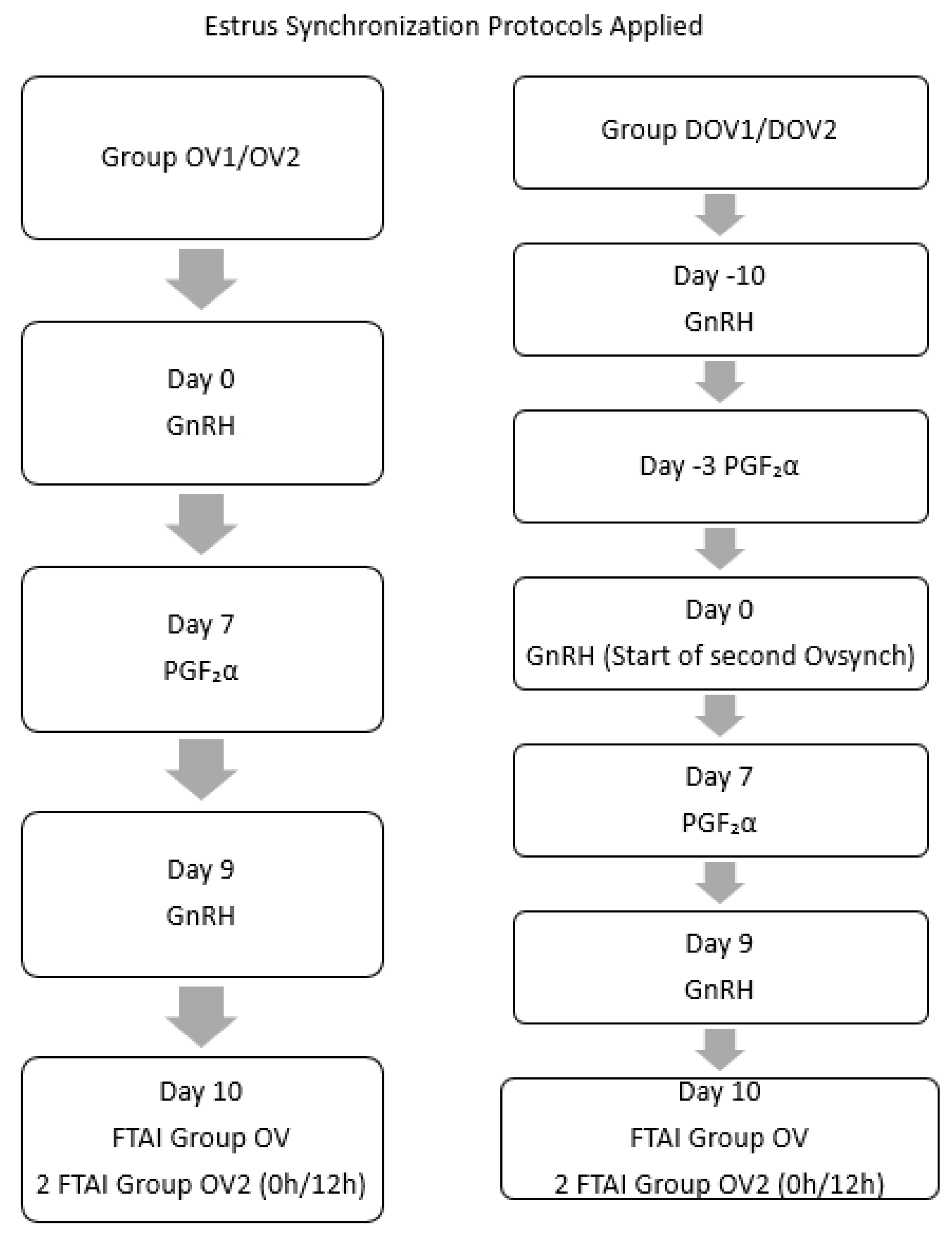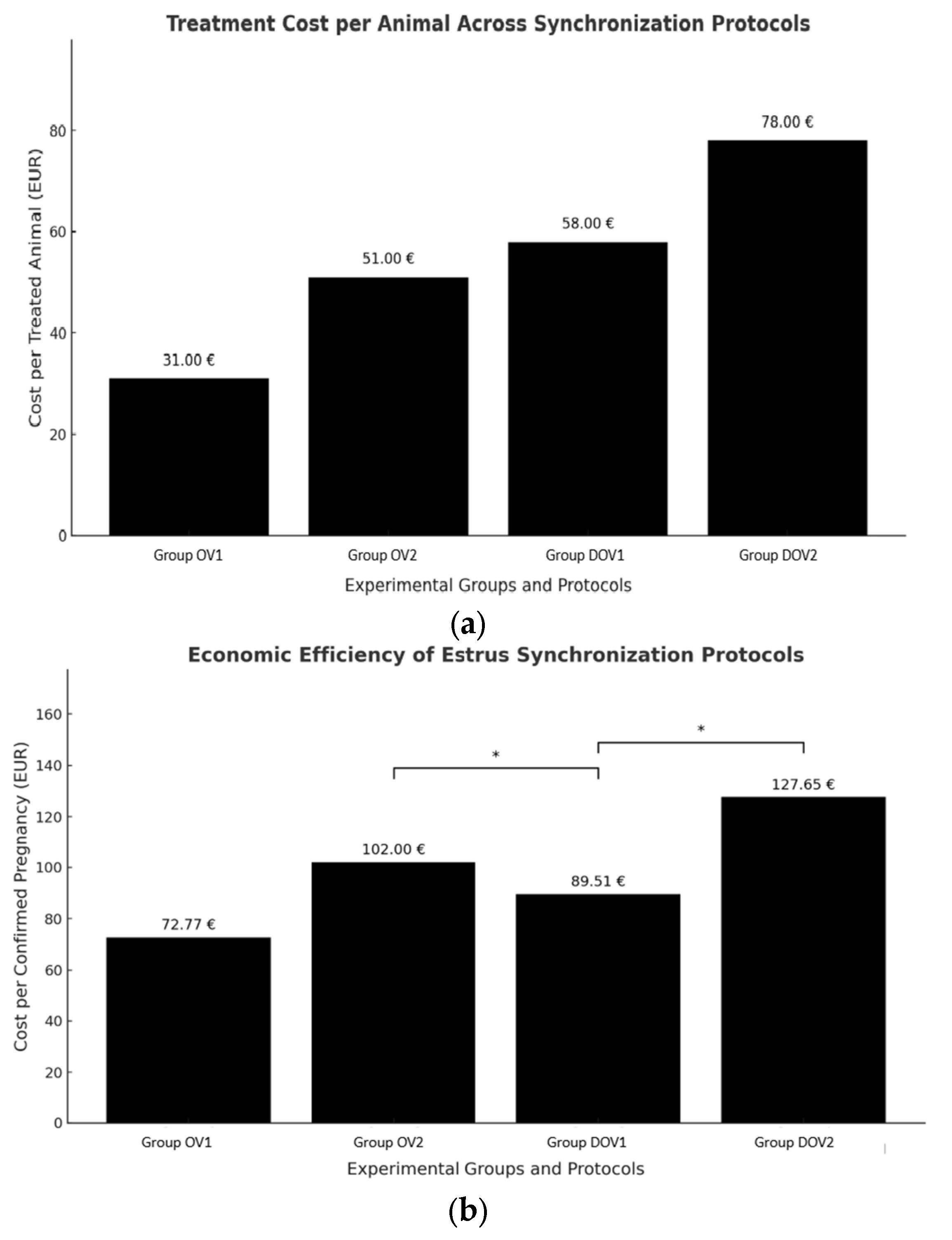Comparative Evaluation of Ovsynch and Double Ovsynch Protocols with Single and Double Insemination in Holstein Dairy Cows: Reproductive Performance and Cost Analysis
Simple Summary
Abstract
1. Introduction
2. Materials and Methods
2.1. Study Location and Duration
2.2. Animal Selection and Experimental Design
- Group OV1: Ovsynch protocol followed by a single fixed-time artificial insemination (FTAI).
- Group OV2: Ovsynch protocol followed by two inseminations, 12 h apart.
- Group DOV1: Double Ovsynch protocol followed by a single FTAI.
- Group DOV2: Double Ovsynch protocol followed by two inseminations, 12 h apart (Table 1).
2.3. Economic Evaluation
- GnRH administration (Receptal): 4 EUR/dose.
- PGF2α administration (Estrumate): 3 EUR/dose.
- Artificial insemination (sexed semen + labor): 20 EUR/insemination.
- Pregnancy diagnosis (transrectal ultrasonography): 4 EUR/examination.
2.4. Statistical Analysis
3. Results
3.1. Pregnancy Results
3.2. Economic Results
4. Discussion
5. Conclusions
Supplementary Materials
Author Contributions
Funding
Institutional Review Board Statement
Informed Consent Statement
Data Availability Statement
Conflicts of Interest
References
- Macmillan, K.L. Recent advances in the synchronization of estrus and ovulation in dairy cows. J. Reprod. Dev. 2010, 56, S42–S47. [Google Scholar] [CrossRef] [PubMed]
- Senger, P.L. The estrus detection problem: New concepts, technologies, and possibilities. J. Dairy. Sci. 1994, 77, 2745–2753. [Google Scholar] [CrossRef] [PubMed]
- Endo, N. Possible causes and treatment strategies for the estrus and ovulation disorders in dairy cows. J. Reprod. Dev. 2022, 68, 85–89. [Google Scholar] [CrossRef] [PubMed] [PubMed Central]
- Rutten, C.J.; Velthuis, A.G.J.; Steeneveld, W.; Hogeveen, H. Invited review: Sensors to support health management on dairy farms. J. Dairy. Sci. 2013, 96, 1928–1952. [Google Scholar] [CrossRef] [PubMed]
- Gilbert, R.O. Management of Reproductive Disease in Dairy Cows. Vet. Clin. N. Am. Food Anim. Pract. 2016, 32, 387–410. [Google Scholar] [CrossRef] [PubMed]
- Melendez, P.; Risco, C.A. Management of transition cows to optimize reproductive efficiency in dairy herds. Vet. Clin. N. Am. Food Anim. Pract. 2005, 21, 485–501. [Google Scholar] [CrossRef] [PubMed]
- Cardoso Consentini, C.E.; Wiltbank, M.C.; Sartori, R. Factors That Optimize Reproductive Efficiency in Dairy Herds with an Emphasis on Timed Artificial Insemination Programs. Animals 2021, 11, 301. [Google Scholar] [CrossRef] [PubMed] [PubMed Central]
- Bisinotto, R.S.; Ribeiro, E.S.; Santos, J.E. Synchronisation of ovulation for management of reproduction in dairy cows. Animal 2014, 8 (Suppl. S1), 151–159. [Google Scholar] [CrossRef] [PubMed]
- Borchardt, S.; Haimerl, P.; Pohl, A.; Heuwieser, W. Evaluation of prostaglandin F2α versus prostaglandin F2α plus gonadotropin-releasing hormone as Presynch methods preceding an Ovsynch in lactating dairy cows: A meta-analysis. J. Dairy Sci. 2017, 100, 4065–4077. [Google Scholar] [CrossRef] [PubMed]
- Nowicki, A.; Barański, W.; Baryczka, A.; Janowski, T. OvSynch Protocol and its Modifications in the Reproduction Management of Dairy Cattle Herds—An Update. J. Vet. Res. 2017, 61, 329–336. [Google Scholar] [CrossRef] [PubMed] [PubMed Central]
- Coman, S.; Berean, D.I.; Cimpean, R.; Ciupe, S.; Coman, I.; Bogdan, L.M. Clinical Modalities for Enhancing Reproductive Efficiency in Buffaloes: A Review and Practical Aspects for Veterinary Practitioners. Animals 2024, 14, 2642. [Google Scholar] [CrossRef] [PubMed] [PubMed Central]
- Jeong, J.K.; Kim, U.H.; Kim, I.H. Efficacy of a modified Double-Ovsynch protocol for the enhancement of reproductive performance in Hanwoo cattle. Anim. Biosci. 2023, 36, 591–600. [Google Scholar] [CrossRef] [PubMed] [PubMed Central]
- Minela, T.; Santos, A.; Pursley, J.R. Estrogen to progesterone ratio is associated with conceptus attachment in dairy cows receiving artificial insemination after Double-Ovsynch but not estrus†. Biol. Reprod. 2024, 111, 919–930. [Google Scholar] [CrossRef] [PubMed] [PubMed Central]
- Pereira, M.H.C.; Wiltbank, M.C.; Barbosa, L.F.S.P.; Costa, W.M., Jr.; Carvalho, M.A.P.; Vasconcelos, J.L.M. Effect of adding a gonadotropin-releasing-hormone treatment at the beginning and a second prostaglandin F2α treatment at the end of an estradiol-based protocol for timed artificial insemination in lactating dairy cows during cool or hot seasons of the year. J. Dairy. Sci. 2015, 98, 947–959. [Google Scholar] [CrossRef] [PubMed]
- Dolecheck, K.A.; Silvia, W.J.; Heersche, G., Jr.; Wood, C.L.; McQuerry, K.J.; Bewley, J.M. A comparison of timed artificial insemination and automated activity monitoring with hormone intervention in 3 commercial dairy herds. J. Dairy. Sci. 2016, 99, 1506–1514. [Google Scholar] [CrossRef] [PubMed]
- Yamada, K. Development of ovulation synchronization and fixed time artificial insemination in dairy cows. J. Reprod. Dev. 2005, 51, 177–186. [Google Scholar] [CrossRef] [PubMed]
- Stevenson, J.S.; Call, E.P.; Scoby, R.K.; Phatak, A.P. Double insemination and gonadotropin-releasing hormone treatment of repeat-breeding dairy cattle. J. Dairy. Sci. 1990, 73, 1766–1772. [Google Scholar] [CrossRef] [PubMed]
- Laplacette, A.L.; Rial, C.; Sitko, E.; Perez, M.M.; Tompkins, S.; Stangaferro, M.L.; Thomas, M.J.; Giordano, J.O. Delaying induction of ovulation and timed artificial insemination in a Double-Ovsynch protocol increased expression of estrus and altered first-service reproductive outcomes of lactating dairy cows. J. Dairy. Sci. 2025, 108, 1103–1124. [Google Scholar] [CrossRef] [PubMed]
- LeBlanc, S. The Ovsynch Breeding Program for Dairy Cows: A Review and Economic Perspective. Bov. Pract. 2001, 35, 13–22. [Google Scholar] [CrossRef]
- Giordano, J.O.; Wiltbank, M.C.; Guenther, J.N.; Pawlisch, R.; Bas, S.; Cunha, A.P.; Fricke, P.M. Increased fertility in lactating dairy cows resynchronized with Double-Ovsynch compared with Ovsynch initiated 32 d after timed artificial insemination. J. Dairy. Sci. 2012, 95, 639–653. [Google Scholar] [CrossRef] [PubMed]
- Jaśkowski, J.M.; Gehrke, M.; Herudzińska, M.; Jaśkowski, B.M.; Brüssow, K.P. Resynchronisation as an Element of Improving Cattle Reproduction Efficiency. J. Vet. Res. 2019, 63, 107–115. [Google Scholar] [CrossRef] [PubMed] [PubMed Central]
- Consentini, C.E.C.; Abadia, T.; Galindez, J.P.A.; Lopes, A.L.M.; Ferro, P.P.C.; Pazini, Y.E.; Faria, N.V.; Machado, F.; Capella, T.; Dos Santos, T.N.; et al. Fertility programs for lactating dairy cows: A novel presynch + timed artificial insemination program (Double E-Synch) produces similar ovarian dynamics, synchronization, and fertility as Double-Ovsynch. J. Dairy Sci. 2025, 108, 4435–4447. [Google Scholar] [CrossRef] [PubMed]
- López-Gatius, F. Revisiting the Timing of Insemination at Spontaneous Estrus in Dairy Cattle. Animals 2022, 12, 3565. [Google Scholar] [CrossRef] [PubMed] [PubMed Central]
- Carvalho, P.D.; Wiltbank, M.C.; Fricke, P.M. Manipulation of progesterone to increase ovulatory response to the first GnRH treatment of an Ovsynch protocol in lactating dairy cows receiving first timed artificial insemination. J. Dairy Sci. 2015, 98, 8800–8813. [Google Scholar] [CrossRef] [PubMed]
- Fricke, P.M.; Wiltbank, M.C. Symposium review: The implications of spontaneous versus synchronized ovulations on the reproductive performance of lactating dairy cows. J. Dairy Sci. 2022, 105, 4679–4689. [Google Scholar] [CrossRef] [PubMed]
- Cabrera, V.E. Economics of fertility in high-yielding dairy cows on confined TMR systems. Animal 2014, 8 (Suppl. S1), 211–221. [Google Scholar] [CrossRef] [PubMed]
- Chebel, R.C.; Santos, J.E.; Cerri, R.L.; Rutigliano, H.M.; Bruno, R.G. Reproduction in dairy cows following progesterone insert presynchronization and resynchronization protocols. J. Dairy Sci. 2006, 89, 4205–4219. [Google Scholar] [CrossRef] [PubMed]
- Santos, J.E.; Bisinotto, R.S.; Ribeiro, E.S.; Lima, F.S.; Greco, L.F.; Staples, C.R.; Thatcher, W.W. Applying nutrition and physiology to improve reproduction in dairy cattle. Soc. Reprod. Fertil. Suppl. 2010, 67, 387–403. [Google Scholar] [CrossRef] [PubMed]
- Yániz, J.L.; Murugavel, K.; López-Gatius, F. Recent developments in oestrous synchronization of postpartum dairy cows with and without ovarian disorders. Reprod. Domest. Anim. 2004, 39, 86–93. [Google Scholar] [CrossRef] [PubMed]
- Borchardt, S.; Tippenhauer, C.M.; Fricke, P.M.; Heuwieser, W. Economic impact of adding a second prostaglandin F2α treatment during an Ovsynch protocol using a meta-analytical assessment and a stochastic simulation model. J. Dairy. Sci. 2021, 104, 12153–12163. [Google Scholar] [CrossRef] [PubMed]
- Peter, A.T.; Vos, P.L.; Ambrose, D.J. Postpartum anestrus in dairy cattle. Theriogenology 2009, 71, 1333–1342. [Google Scholar] [CrossRef] [PubMed]


| Group | Average BCS (Mean ± SD) | Average DIM (Mean ± SD) | Average Parity (Mean ± SD) |
|---|---|---|---|
| OV1 | 3.18 ± 0.15 | 52.6 ± 4.9 | 2.7 ± 0.5 |
| OV2 | 3.24 ± 0.17 | 53.8 ± 4.6 | 2.9 ± 0.4 |
| DOV1 | 3.16 ± 0.14 | 51.7 ± 4.3 | 2.8 ± 0.5 |
| DOV2 | 3.23 ± 0.16 | 54.1 ± 4.7 | 2.9 ±0.5 |
| Group | Protocol | Pregnant Cows (n/54) | Pregnancy Rate (%) |
|---|---|---|---|
| Group OV1 | Ovsynch + 1 AI | 23/54 | 42.6% * |
| Group OV2 | Ovsynch + 2 AI | 27/54 | 50.0% ns |
| Group DOV1 | Double Ovsynch + 1 AI | 35/54 | 64.8% |
| Group DOV2 | Double Ovsynch + 2 AI | 33/54 | 61.1% ns |
Disclaimer/Publisher’s Note: The statements, opinions and data contained in all publications are solely those of the individual author(s) and contributor(s) and not of MDPI and/or the editor(s). MDPI and/or the editor(s) disclaim responsibility for any injury to people or property resulting from any ideas, methods, instructions or products referred to in the content. |
© 2025 by the authors. Licensee MDPI, Basel, Switzerland. This article is an open access article distributed under the terms and conditions of the Creative Commons Attribution (CC BY) license (https://creativecommons.org/licenses/by/4.0/).
Share and Cite
Berean, D.I.; Bogdan, L.M.; Cimpean, R. Comparative Evaluation of Ovsynch and Double Ovsynch Protocols with Single and Double Insemination in Holstein Dairy Cows: Reproductive Performance and Cost Analysis. Animals 2025, 15, 2380. https://doi.org/10.3390/ani15162380
Berean DI, Bogdan LM, Cimpean R. Comparative Evaluation of Ovsynch and Double Ovsynch Protocols with Single and Double Insemination in Holstein Dairy Cows: Reproductive Performance and Cost Analysis. Animals. 2025; 15(16):2380. https://doi.org/10.3390/ani15162380
Chicago/Turabian StyleBerean, Daniel Ionut, Liviu Marian Bogdan, and Raluca Cimpean. 2025. "Comparative Evaluation of Ovsynch and Double Ovsynch Protocols with Single and Double Insemination in Holstein Dairy Cows: Reproductive Performance and Cost Analysis" Animals 15, no. 16: 2380. https://doi.org/10.3390/ani15162380
APA StyleBerean, D. I., Bogdan, L. M., & Cimpean, R. (2025). Comparative Evaluation of Ovsynch and Double Ovsynch Protocols with Single and Double Insemination in Holstein Dairy Cows: Reproductive Performance and Cost Analysis. Animals, 15(16), 2380. https://doi.org/10.3390/ani15162380






